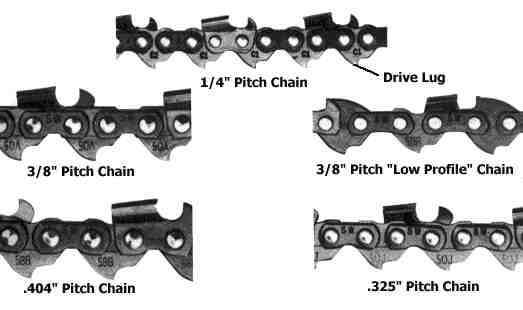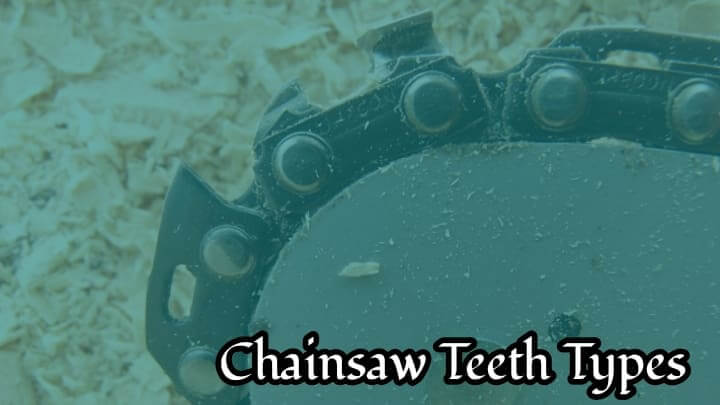Chainsaw teeth are the small, sharp blades that protrude from the chain on a chainsaw. These teeth allow the chainsaw to cut through wood and other materials.
The teeth are classified into different categories, determining their specific purpose and function. Here are the most common types of chainsaw teeth:
Table of Contents
What Are the Different Types of Chainsaw Teeth?
Chain Pitch

One way to classify chainsaw teeth is by their pitch, the distance between any three consecutive rivets divided by two. The pitch determines the size of the chain’s loops and, as a result, the maximum cutting diameter of the saw. It differentiates the types of materials each saw can cut as well. The most common pitches used on chainsaws are 1/4″, 3/8″, and .325″.
1/4 Inch Pitch: This is the smallest pitch used on chainsaws and is typically only used on tiny saws, such as those used for trimming. These teeth are not meant for cutting through the thick wood.
3/8 Inch Pitch: This pitch is used on most standard chainsaws and is versatile enough for various tasks, such as tree felling and firewood cutting. You can also use it for smaller jobs, such as trimming, but it’s less efficient than a 1/4″ pitch saw.
.325 Inch Pitch: This pitch is becoming increasingly popular due to its versatility. It can be used for various tasks, such as tree felling, firewood cutting, and smaller jobs like trimming.
Chain Gauge
Another way to classify chainsaw teeth is by their gauge, which is the thickness of the drive link where it meets the tooth. The most common gauges used on chainsaws are .050″, .058″, and .068″.
.050″ Gauge: This is the thinnest gauge used on chainsaws and is typically only used on tiny saws, such as those used for trimming. With this gauge, there are more teeth per inch (TPI), making the saw cut faster and increasing the risk of kickback.
.058″ Gauge: This is the most common gauge used on chainsaws and is a good balance between cutting speed and kickback risk. It’s versatile enough to be used for various tasks, such as tree felling and firewood cutting.
.068″ Gauge: This is the thickest gauge and is most common on homeowner saws. It is also found on some professional saws used for general purpose felling, limbing and cross-cutting. This gauge provides the least risk of kickback but also cuts the slowest.
Cutter Type or Blade Style

Chainsaw teeth can also be classified by their cutter type, which is the shape of the blade. The most common cutter types are square, chipper, and semi-chisel.
Square Cutters: These cutters have sharp corners and are the most aggressive. They’re suitable for cutting through dirty or frozen wood, as well as greenwood.
Full Chisel Cutters: The cutters have a more rounded shape, making them less aggressive. They’re suitable for cutting through clean wood, and they’re less likely to get stuck in the wood.
Semi-Chisel Cutters: The semi-chisel’s most popular type of saw chain has teeth with rounded corners. The depth gauges are also rounded. These features combine to give the chain cutter teeth a good balance of strength and speed. The rounded depth gauge also helps reduce kickback.
Chamfer Chisel Cutters: Also sometimes called skip tooth, the chamfer chisel has teeth with sharp corners and a depth gauge that is also sharp. These features make the chain very aggressive, allowing it to quickly cut through dirty or frozen wood. However, the sharp depth gauge also increases the risk of kickback.
Chipper Cutters: The chipper cutter has teeth that are very sharp with squared-off corners. They’re designed for cutting through clean wood quickly. However, sharp teeth also increase the risk of kickback.
Low-Profile Cutters: The low-profile cutter has teeth that are more rounded than chipper or square cutters. They’re designed for cutting through clean wood quickly and with less risk of kickback.
Narrow Kerf Cutters: The cutters have a narrower cutting width, making them less aggressive than square or full chisel cutters. They’re good for cutting through clean wood, and they’re less likely to get stuck in the wood.[1]
Cutter Material or Blade Material
Chainsaw teeth can also be classified by their cutter material, which is the blade’s metal. The most common materials used are steel, chrome, tungsten carbide, and diamond. You want to pay attention to the cutter material to affect the saw’s cutting performance and durability.
Steel: Steel is the most common cutter material and is good for general-purpose cutting. It’s affordable and easy to find, but it’s not as durable as other materials. It’s available at cheaper price points but won’t last as long as more expensive options.
Chrome: Chrome is a harder metal than steel and is good for cutting through rigid materials like concrete and asphalt. It is also less likely to dull than other types of cutter materials. The price tag on chrome-tipped cutters is generally lower than that of other cutter materials.
Tungsten Carbide: Tungsten carbide is one of the hardest metals and is good for cutting through extremely tough materials like metal and stone. It’s also more durable than other cutter materials to stay sharp longer. The price tag on tungsten carbide-tipped cutters is generally higher than that of other cutter materials.
Diamond: Diamond is the hardest known material and is good for cutting through the most challenging materials like metal and stone. It’s the most expensive cutter material, but it’s also durable.
Chain Arrangement
Their chain arrangement classifies another way to chainsaw teeth. The most common arrangements are full skip, semi-skip, and full house.
Full Skip: A complete skip chain has teeth spaced further apart than other arrangements. This makes the chain less aggressive and gives it more clearance, which is suitable for cutting through dirty or frozen wood.
Semi-Skip: A semi-skip chain has teeth spaced closer together than a whole skip chain but not as close together as a full house chain. This makes the chain more aggressive than a full skip chain but not as aggressive as a full house chain.
Full House: A full house chain has teeth that are spaced close together. This makes the chain more aggressive than other arrangements and is good for cutting through clean wood.
Final Thought
Choosing the right type of chainsaw teeth depends on what you’ll be using the saw for and what type of material you’ll be cutting through.
And all the above are the many different types of chainsaw teeth. If you’re not sure, it’s always best to consult with a professional before purchasing.
You might read our articles on how to lower compression on a chainsaw and how to make a chainsaw winch.

